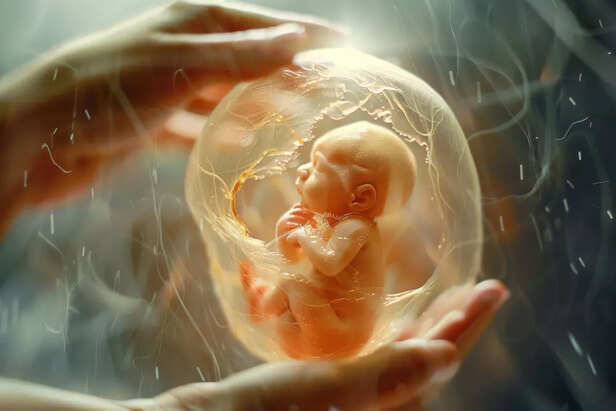World’s First Test Tube Baby? The Mind-Blowing Truth of Guru Dronacharya’s Birth in Mahabharat
Tarun Badghaiya | Mar 06, 2025, 23:56 IST
( Image credit : Timeslife )
The birth of Guru Dronacharya in the Mahabharata is strikingly comparable to modern test-tube baby technology. According to the epic, he was born from a pot (drona in Sanskrit), where Sage Bharadwaja's sperm was stored and cultured outside of the womb. This uncommon birth method is similar to in vitro fertilisation (IVF), in which conception happens outside the human body. Similar cases, such as the Kauravas' birth from incubated flesh, point to ancient knowledge of artificial reproduction. While these stories are mostly mythological, they raise interesting questions regarding whether early civilizations had profound scientific understanding long before current advances.
The Mahabharata, one of the greatest epics of ancient India, has stories that combine mythology, history, and science. One such captivating story is the birth of Guru Dronacharya, the mythical teacher of the Kauravas and Pandavas. Some researchers and fans believe his birth was similar to modern in-vitro fertilisation (IVF), making him one of the first examples of a "test-tube baby."
Guru Dronacharya was the son of Sage Bharadwaja, a respected Rishi famed for his extensive understanding of the Vedas and military sciences. According to the Mahabharata, one day, while Bharadwaja was performing his morning rituals near the Ganges, he saw a beautiful apsara (celestial nymph) named Ghritachi. Captivated by her beauty, his body reacted involuntarily, and he emitted reproductive fluid. Bharadwaja, a yogi with enormous strength, collected this fluid in a drona (a vessel or container). A child was born from this vessel, and he was named Dronacharya (Drona, meaning "born of a vessel").

A
In modern scientific terminology, Dronacharya's birth bears striking similarities to in-vitro fertilisation (IVF) and test tube baby technology. While Bharadwaja did not practice traditional conception, his genetic material resulted in the birth of a child via an external technique, similar to how test-tube infants are born today.
This strange resemblance has prompted some to assume that the ancient sages of India may have been aware of superior reproduction technology long before contemporary science found them.
Dronacharya's birth isn't the only instance of an exceptional conception in Hindu mythology. Several other figures were born in unusual circumstances, lending credence to the theory that ancient Indians were knowledgeable of reproductive science.
The hypothesis that Dronacharya's birth was an early kind of test-tube conception is certainly intriguing. Scholars are split on whether these stories represent scientific breakthroughs or are just allegorical.
1. Supporters of the Ancient Science Theory say that Indian rishis were well-versed in medicine, genetics, and embryology. The Charaka Samhita and Sushruta Samhita are texts that explain surgical operations, organ transplants, and even artificial reproductive techniques.
2. Skeptics and rationalists believe these stories are metaphorical rather than literal. They suggest that such myths symbolize the power of divine will rather than hidden scientific knowledge.

Whether one considers Dronacharya's birth to be a legendary story or an example of profound scientific understanding in ancient India, there is little doubt that the Mahabharata has themes that continue to fascinate and inspire. The concept of a test-tube baby dating back thousands of years calls into question our understanding of history and science. While contemporary IVF technology has made assisted reproduction a reality, it's possible that ancient Indian sages were already familiar with the concept in ways we don't completely understand.
The Mysterious Birth of Dronacharya

ivf
( Image credit : Timeslife )
A Test Tube Baby from Ancient Times?
This is how the comparison works.
Modern IVF: In today's world, an egg and sperm are fertilised in a lab (test tube or petri dish) before being placed in the mother's womb.
Dronacharya was born in a sacred vessel (drona) rather than a human womb. There was no direct physical interaction between Bharadwaja and his female lover.
This strange resemblance has prompted some to assume that the ancient sages of India may have been aware of superior reproduction technology long before contemporary science found them.
Other Examples of Unusual Births in Hindu Mythology
1. Karna: He was born from Kunti by the heavenly blessing of Surya (the Sun God) with no physical conception. This can be compared to parthenogenesis (virgin birth).
2. The Kauravas-Gandhari gave birth to a pile of flesh, which was then divided into 100 parts and nurtured in jars, resulting in the hundred Kaurava brothers. This closely mimics modern embryo culture in controlled conditions.
3. Sage Agastya, like Dronacharya, was born from a pot, adding another dimension to the notion that ancient sages had access to superior reproductive techniques.
Mythology or science? The Debate Continues
1. Supporters of the Ancient Science Theory say that Indian rishis were well-versed in medicine, genetics, and embryology. The Charaka Samhita and Sushruta Samhita are texts that explain surgical operations, organ transplants, and even artificial reproductive techniques.
2. Skeptics and rationalists believe these stories are metaphorical rather than literal. They suggest that such myths symbolize the power of divine will rather than hidden scientific knowledge.

ivf
( Image credit : Timeslife )
Whether one considers Dronacharya's birth to be a legendary story or an example of profound scientific understanding in ancient India, there is little doubt that the Mahabharata has themes that continue to fascinate and inspire. The concept of a test-tube baby dating back thousands of years calls into question our understanding of history and science. While contemporary IVF technology has made assisted reproduction a reality, it's possible that ancient Indian sages were already familiar with the concept in ways we don't completely understand.
